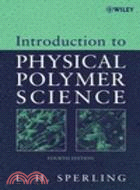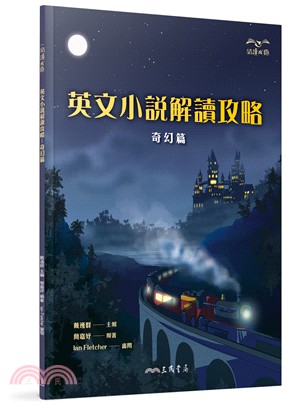Introduction To Physical Polymer Science, Fourth Edition
商品資訊
ISBN13:9780471706069
出版社:John Wiley & Sons Inc
作者:Sperling
出版日:2005/11/23
裝訂/頁數:平裝/880頁
定價
:NT$ 5356 元優惠價
:90 折 4820 元
若需訂購本書,請電洽客服 02-25006600[分機130、131]。
商品簡介
作者簡介
目次
相關商品
商品簡介
An Updated Edition of the Classic Text
Polymers constitute the basis for the plastics, rubber, adhesives, fiber, and coating industries. The Fourth Edition of Introduction to Physical Polymer Science acknowledges the industrial success of polymers and the advancements made in the field while continuing to deliver the comprehensive introduction to polymer science that made its predecessors classic texts.
The Fourth Edition continues its coverage of amorphous and crystalline materials, glass transitions, rubber elasticity, and mechanical behavior, and offers updated discussions of polymer blends, composites, and interfaces, as well as such basics as molecular weight determination. Thus, interrelationships among molecular structure, morphology, and mechanical behavior of polymers continue to provide much of the value of the book.
Newly introduced topics include:
* Nanocomposites, including carbon nanotubes and exfoliated montmorillonite clays
* The structure, motions, and functions of DNA and proteins, as well as the interfaces of polymeric biomaterials with living organisms
* The glass transition behavior of nano-thin plastic films
In addition, new sections have been included on fire retardancy, friction and wear, optical tweezers, and more.
Introduction to Physical Polymer Science, Fourth Edition provides both an essential introduction to the field as well as an entry point to the latest research and developments in polymer science and engineering, making it an indispensable text for chemistry, chemical engineering, materials science and engineering, and polymer science and engineering students and professionals.
Polymers constitute the basis for the plastics, rubber, adhesives, fiber, and coating industries. The Fourth Edition of Introduction to Physical Polymer Science acknowledges the industrial success of polymers and the advancements made in the field while continuing to deliver the comprehensive introduction to polymer science that made its predecessors classic texts.
The Fourth Edition continues its coverage of amorphous and crystalline materials, glass transitions, rubber elasticity, and mechanical behavior, and offers updated discussions of polymer blends, composites, and interfaces, as well as such basics as molecular weight determination. Thus, interrelationships among molecular structure, morphology, and mechanical behavior of polymers continue to provide much of the value of the book.
Newly introduced topics include:
* Nanocomposites, including carbon nanotubes and exfoliated montmorillonite clays
* The structure, motions, and functions of DNA and proteins, as well as the interfaces of polymeric biomaterials with living organisms
* The glass transition behavior of nano-thin plastic films
In addition, new sections have been included on fire retardancy, friction and wear, optical tweezers, and more.
Introduction to Physical Polymer Science, Fourth Edition provides both an essential introduction to the field as well as an entry point to the latest research and developments in polymer science and engineering, making it an indispensable text for chemistry, chemical engineering, materials science and engineering, and polymer science and engineering students and professionals.
作者簡介
Trained as a chemist, L. H. SPERLING is Professor Emeritus of both Chemical Engineering and Materials Science and Engineering at Lehigh University in Bethlehem, Pennsylvania. He remains active in consulting, speaking, and writing.
目次
Preface to the Fourth Edition.
Preface to the First Edition.
Symbols and Definitions.
1. Introduction to Polymer Science.
1.1. From Little Molecules to Big Molecules.
1.2. Molecular Weight and Molecular Weight Distributions.
1.2.1. Effect on Tensile Strength.
1.2.2. Molecular Weight Averages.
1.3. Major Polymer Transitions.
1.4. Polymer Synthesis and Structure.
1.4.1. Chain Polymerization.
1.4.1.1. Free Radical Polymerization.
1.4.1.2. Initiation.
1.4.1.3. Propagation.
1.4.1.4. Termination.
1.4.1.5. Structure and Nomenclature.
1.4.2. Step Polymerization.
1.4.2.1. A Polyester Condensation Reaction.
1.4.2.2. Stepwise Nomenclature and Structures.
1.4.2.3. Natural Product Polymers.
1.5. Cross-Linking, Plasticizers, and Fillers.
1.6. The Macromolecular Hypothesis.
1.7. Historical Development of Industrial Polymers.
1.8. Molecular Engineering.
References.
General Reading.
Handbooks, Encyclopedias, and Dictionaries.
Web Sites.
Study Problems.
Appendix 1.1. Names for Polymers.
2. Chain Structure and Configuration.
2.1. Examples of Configurations and Conformations.
2.1.1. Head-to-Head and Head-to-Tail Configurations.
2.1.2. Trans-Gauche Conformations.
2.2. Theory and Instruments.
2.2.1. Chemical Methods of Determining Microstructure.
2.2.2. General Physical Methods.
2.2.3. Infrared and Raman Spectroscopic Characterization.
2.2.4. Nuclear Magnetic Resonance Methods.
2.3. Stereochemistry of Repeating Units.
2.3.1. Chiral Centers.
2.3.2. Tacticity in Polymers.
2.3.3. Meso- and Racemic Placements.
2.3.4. Proton Spectra by NMR.
2.4. Repeating Unit Isomerism.
2.4.1. Optical Isomerism.
2.4.2. Geometric Isomerism.
2.4.3. Substitutional Isomerism.
2.4.4. Infrared and Raman Spectroscopic Characterization.
2.5. Common Types of Copolymers.
2.5.1. Unspecified Copolymers.
2.5.2. Statistical Copolymers.
2.5.3. Random copolymers.
2.5.4. Alternating Copolymers.
2.5.5. Periodic Copolymers.
2.6. NMR in Modern Research.
2.6.1. Dilute Solution Studies: Mer Distribution.
2.6.2. High-Resolution NMR in the Solid State.
2.7. Multicomponent Polymers.
2.7.1. Block Copolymers.
2.7.2. Graft Copolymers.
2.7.3. AB-Cross-linked Copolymers.
2.7.4. Interpenetrating Polymer Networks.
2.7.5. Other Polymer-Polymer Combinations.
2.7.6. Separation and Identification of Multicomponent Polymers.
2.8. Conformational States in Polymers.
2.9. Analysis of Polymers during Mechanical Strain.
2.10. Photophysics of Polymers.
2.10.1. Quenching Phenomena.
2.10.2. Excimer Formation.
2.10.3. Experimental Studies.
2.10.3.1. Microstructure of Polystyrene.
2.10.3.2. Excimer Stability.
2.11. Configuration and Conformation.
References.
General Reading.
Study Problems.
Appendix 2.1. Assorted Isomeric and Copolymer Macromolecules.
3. Dilute Solution Thermodynamics, Molecular Weights, and Sizes.
3.1. Introduction.
3.1.1. Polymer Size and Shape.
3.1.2. How Does a Polymer Dissolve?.
3.2. The Solubility Parameter.
3.2.1. Solubility Parameter Tables.
3.2.2. Experimental Determination.
3.2.3. Theoretical Calculation: An Example.
3.3. Thermodynamics of Mixing.
3.3.1. Types of Solutions.
3.3.1.1. The Ideal Solution.
3.3.1.2. Statistical Thermodynamics of Mixing.
3.3.1.3. Other Types of Solutions.
3.3.2. Dilute Solutions.
3.3.3. Values of the Flory-Huggins c1 Parameter.
3.3.4. A Worked Example for the Free Energy of Mixing.
3.4. Molecular Weight Averages.
3.5. Determination of the Number-Average Molecular Weight.
3.5.1. End-Group Analyses.
3.5.2 Colligative Properties.
3.5.3. Osmotic Pressure.
3.5.3.1. Thermodynamic Basis.
3.5.3.2. Instrumentation.
3.5.3.3. The Flory q-Temperature.
3.6. Weight-Average Molecular Weights and Radii of Gyration.
3.6.1. Scattering Theory and Formulations.
3.6.2. The Appropriate Angular Range.
3.6.3. The Zimm Plot.
3.6.4. Polymer Chain Dimensions and Random Coils.
3.6.5. Scattering Data.
3.6.6. Dynamic Light-Scattering.
3.7. Molecular Weights of Polymers.
3.7.1. Molecular Weights of Polymers.
3.7.2. Thermodynamics and Kinetics of Polymerization.
3.7.2.1. Thermodynamics of Chain Polymerization.
3.7.2.2. Kinetics of Chain Polymerization.
3.7.2.3. Thermodynamics of Step Polymerization.
3.7.2.4. Kinetics of Step Polymerizations.
3.7.3. Molecular Weight Distributions.
3.7.4. Gelation and Network Formation.
3.8. Intrinsic Viscosity.
3.8.1. Definition of Terms.
3.8.2. The Equivalent Sphere Model.
3.8.3. The Mark-Houwink Sakurada Relationship.
3.8.4. Intrinsic Viscosity Experiments.
3.8.5. Example Calculation Involving Intrinsic Viscosity.
3.9. Gel Permeation Chromatography.
3.9.1. Theory of Gel Permeation Chromatography.
3.9.2. Utilization of Distribution Coefficients in GPC and HPLC.
3.9.3. Types of Chromatography.
3.9.4. GPC Instrumentation.
3.9.5. Calibration.
3.9.6. Selected Current Research Problems.
3.9.7. The Universal Calibration.
3.9.8. Properties of Cyclic Polymers.
3.10. Mass Spectrometry.
3.10.1. High Molecular Weight Studies.
3.10.2. Advances Using MALDI Techniques.
3.10.2.1. Small Sample Size.
3.10.2.2. Oligomer and Telomer-Type Studies.
3.10.2.3. Calibration of Results.
3.11. Instrumentation for Molecular Weight Determination.
3.12. Solution Thermodynamics and Molecular Weights.
References.
General Reading.
Study Problems.
Appendix 3.1. Calibration and Application of Light-Scattering.
Instrumentation for the Case Where P(q) = 1 / 142.
4. Concentrated Solutions, Phase Separation Behavior, and Diffusion.
4.1. Phase Separation and Fractionation.
4.1.1. Motor Oil Viscosity Example.
4.1.2. Polymer-Solvent Systems.
4.1.3. Vitrification Effects.
4.2. Regions of the Polymer-Solvent Phase Diagram.
4.3. Polymer-Polymer Phase Separation.
4.3.1. Phase Diagrams.
4.3.2. Thermodynamics of Phase Separation.
4.3.3. An Example Calculation: Molecular Weight Miscibility Limit.
4.3.4. Equation of State Theories.
4.3.5. Kinetics of Phase Separation.
4.3.6. Miscibility in Statistical Copolymer Blends.
4.3.7. Polymer Blend Characterization.
4.3.8. Graft Copolymers and IPNs.
4.3.9. Block Copolymers.
4.3.10. Example Calculations with Block Copolymers.
4.3.11. Ionomers.
4.4. Diffusion and Permeability in Polymers.
4.4.1. Swelling Phenomena.
4.4.2. Fick's Laws.
4.4.3. Permeability Units.
4.4.4. Permeability Data.
4.4.5. Effect of Permeant Size.
4.4.6. Permselectivity of Polymeric Membranes and Separations.
4.4.6.1. Types of Membranes.
4.4.6.2. Gas Separations.
4.4.7. Gas Permeability in Polymer Blends.
4.4.8. Fickian and Non-Fickian Diffusion.
4.4.9. Controlled Drug Delivery via Diffusion.
4.4.9.1. Methods of Incorporating Drugs into Polymers.
4.4.9.2. Drug Diffusion Kinetics.
4.4.9.3. Design of Transdermal Delivery Systems.
4.5. Latexes and Suspensions.
4.5.1. Natural Rubber Latex.
4.5.2. Colloidal stability and Film Formation.
4.6. Multicomponent and Multiphase Materials.
References.
General Reading.
Study Problems.
Appendix 4.1. Scaling Law Theories and Applications.
5. The Amorphous State.
5.1. The Amorphous Polymer State.
5.1.1. Solids and Liquids.
5.1.2. Possible Residual Order in Amorphous Polymers?.
5.2. Experimental Evidence Regarding Amorphous Polymers.
5.2.1. Short-Range Interactions in Amorphous Polymers.
5.2.2. Long-Range Interactions in Amorphous Polymers.
5.2.2.1. Small-Angle Neutron Scattering.
5.2.2.2. Electron and X-Ray Diffraction.
5.2.2.3. General Properties.
5.3. Conformation of the Polymer Chain.
5.3.1. Models and Ideas.
5.3.1.1. The Freely Jointed Chain.
5.3.1.2. Kuhn Segments.
5.3.2. The Random Coil.
5.3.3. Models of Polymer Chains in the Bulk Amorphous State.
5.4. Macromolecular Dynamics.
5.4.1. The Rouse-Bueche Theory.
5.4.2. Reptation and Chain Motion.
5.4.2.1. The de Gennes Reptation Theory.
5.4.2.2. Fickian and Non-Fickian Diffusion.
5.4.3. Nonlinear Chains.
5.4.4. Experimental Methods of Determining Diffusion Coefficients.
5.5. Concluding Remarks.
References.
General Reading.
Study Problems.
Appendix 5.1. History of the Random Coil Model for Polymer Chains.
Appendix 5.2. Calculations Using the Diffusion Coefficient.
Appendix 5.3. Nobel Prize Winners in Polymer Science and Engineering.
6. The Crystalline State.
6.1. General Considerations.
6.1.1. Historical Aspects.
6.1.2. Melting Phenomena.
6.1.3. Example Calculation of Percent Crystallinity.
6.2. Methods of Determining Crystal Structure.
6.2.1. A Review of Crystal Structure.
6.2.2. X-Ray methods.
6.2.3. Electron Diffraction of Single Crystals.
6.2.4. Infrared Absorption.
6.2.5. Raman Spectra.
6.3. The Unit Cell of Crystalline Polymers.
6.3.1. Polyethylene.
6.3.2. Other Polyolefin Polymers.
6.3.3. Polar Polymers and Hydrogen Bonding.
6.3.4. Polymorphic Forms of Cellulose.
6.3.5. Principles of Crystal Structure Determination.
6.4. Structure of Crystalline Polymers.
6.4.1. The Fringed Micelle Model.
6.4.2. Polymer Single Crystals.
6.4.2.1. The Folded-Chain Model.
6.4.2.2. The Switchboard Model.
6.5. Crystallization from the Melt.
6.5.1. Spherulitic Morphology.
6.5.2. Mechanism of Spherulite Formation.
6.5.3. Spherulites in Polymer Blends and Block Copolymers.
6.5.4. Percent Crystallinity in Polymers.
6.6. Kinetics of Crystallization.
6.6.1. Experimental Observations of Crystallization Kinetics.
6.6.2. Theories of Crystallization Kinetics.
6.6.2.1. The Avrami Equation.
6.6.2.2. Keith-Padden Kinetics of Spherulitic Crystallization.
6.6.2.3. Hoffman's Nucleation Theory.
6.6.2.4. Example Calculation of the Fold Surface Free Energy.
6.6.2.5. Three Regimes of Crystallization Kinetics.
6.6.3. Analysis of the Three Crystallization Regimes.
6.6.3.1. Kinetics of Crystallization.
6.6.3.2. Experimental Data on Regimes I, II, and III.
6.6.3.3. Changes in Crystal Growth Habit.
6.6.4. The Entropic Barrier Theory.
6.7. The Reentry Problem in Lamellae.
6.7.1. Infrared Spectroscopy.
6.7.2. Carbon-13 NMR.
6.7.3. Small-Angle Neutron Scattering.
6.7.3.1. Single-Crystal Studies.
6.7.3.2. Melt-Crystallized Polymers.
6.7.4. Extended Chain Crystals.
6.8. Thermodynamics of Fusion.
6.8.1. Theory of Melting Point Depression.
6.8.2. Example Calculation of Melting Point Depression.
6.8.3. Experimental Thermodynamic Parameters.
6.8.4. Entropy of Melting.
6.8.5. The Hoffman-Weeks Equilibrium Melting Temperature.
6.9. Effect of Chemical Structure on the Melting Temperature.
6.10. Fiber Formation and Structure.
6.10.1. X-Ray Fiber Diagrams.
6.10.2. Natural Fibers.
6.11. The Hierarchical Structure of Polymeric Materials.
6.12. How Do You Know It's a Polymer?.
References.
General Reading.
Study Problems.
7. Polymers in the Liquid Crystalline State.
7.1. Definition of a Liquid Crystal.
7.2. Rod-Shaped Chemical Structures.
7.3. Liquid Crystalline Mesophases.
7.3.1. Mesophase Topologies.
7.3.2. Phase Diagrams.
7.3.3. First-Order Transitions.
7.4. Liquid Crystal Classification.
7.4.1. Lyotropic Liquid Crystalline Chemical Structures.
7.4.2. Thermotropic Liquid Crystalline Chemical Structures.
7.4.3. Side-Chain Liquid Crystalline Chemical Structures.
7.5. Thermodynamics and Phase Diagrams.
7.5.1. Historical Aspects.
7.5.2. Importance of the c1 Parameter.
7.6. Mesophase Identification in Thermotropic Polymers.
7.7. Fiber Formation.
7.7.1. Viscosity of Lyotropic Solutions.
7.7.2. Molecular Orientation.
7.8. Comparison of Major Polymer Types.
7.8.1. Molecular Conformation.
7.8.2. Properties in bulk.
7.9. Basic Requirements for Liquid Crystal Formation.
References.
General Reading.
Study Problems.
8. Glass-Rubber Transition Behavior.
8.1. Simple Mechanical Relationships.
8.1.1. Modulus.
8.1.1.1. Young's Modulus.
8.1.1.2. Shear Modulus.
8.1.2. Newton's Law.
8.1.3. Poisson's Ratio.
8.1.4. The Bulk Modulus and Compressibility.
8.1.5. Relationships among E, G, B, and n.
8.1.6. Compliance versus Modulus.
8.1.7. Numerical Values for E.
8.1.8. Storage and Loss Moduli.
8.1.9. Elongational Viscosity.
8.2. Five Regions of Viscoelastic Behavior.
8.2.1. The Glassy Region.
8.2.2. The Glass Transition Region.
8.2.3. The Rubbery Plateau Region.
8.2.4. The Rubbery Flow Region.
8.2.5. The Liquid flow Region.
8.2.6. Effect of Plasticizers.
8.2.7. Definitions of the Terms "Transition," "Relaxation," and "Dispersion".
8.2.8. Melt Viscosity Relationships Near TG.
8.2.9. Dynamic Mechanical Behavior through the Five Regions.
8.3. Methods of Measuring Transitions in Polymers.
8.3.1. Dilatometry Studies.
8.3.2. Thermal Methods.
8.3.3. Mechanical Methods.
8.3.4. Dielectric and Magnetic Methods.
8.3.5. A Comparison of the Methods.
8.3.6. The Cole-Cole Plot.
8.4. Other Transitions and Relaxations.
8.4.1. The Schatzki Crankshaft Mechanism.
8.4.1.1. The Main-Chain Motions.
8.4.1.2. Side-Chain Motions.
8.4.2. The Tll Transition.
8.5. Time and Frequency Effects on Relaxation Processes.
8.5.1. Time Dependence in Dilatometric Studies.
8.5.2. Time Dependence in Mechanical Relaxation Studies.
8.5.3. Frequency Effects in Dynamic Experiments.
8.6. Theories of the Glass Transition.
8.6.1. The Free-Volume Theory.
8.6.1.1. TG as an ISO-Free-Volume State.
8.6.1.2. The WLF Equation.
8.6.1.3. An Example of WLF Calculations.
8.6.2. The Kinetic Theory of the Glass Transition.
8.6.2.1. Estimations of the Free-Volume Hole Size in Polymers.
8.6.2.2. Positron Annihilation Lifetime Spectroscopy.
8.6.3. Thermodynamic Theory of TG.
8.6.3.1. The Gibbs and DiMarzio Theory.
8.6.3.2. Effect of Cross-Link Density on TG.
8.6.3.3. A Summary of the Glass Transition Theories.
8.6.3.4. A Unifying Treatment.
8.7. Effect of Molecular Weight on TG.
8.7.1. Linear Polymers.
8.7.2. Effect of TG on Polymerization.
8.8. Effect of Copolymerization on TG.
8.8.1. One-Phase Systems.
8.8.2. Two-Phase Systems.
8.9. Effect of Crystallinity on TG.
8.9.1. The Glass Transition of Polyethylene.
8.9.2. The Nylon Family Glass Transition.
8.9.3. Relationships between TG and TF.
8.9.4. Heat Distortion Temperature.
8.10. Dependence of TG on Chemical Structure.
8.10.1. Effect of Aliphatic Side Groups on TG.
8.10.2. Effect of Tacticity on TG.
8.11. Effect of Pressure on TG.
8.12. Damping and Dynamic Mechanical Behavior.
8.13. Definitions of Elastomers, Plastics, Adhesives, and Fibers.
References.
General Reading.
Study Problems.
Appendix 8.1. Molecular Motion near the Glass Transition.
9. Cross-linked Polymers and Rubber Elasticity.
9.1. Cross-links and Networks.
9.1.1. The Sol-Gel Transition.
9.1.2. Micronetworks.
9.2. Historical Development of Rubber.
9.2.1. Early Developments.
9.2.2. Modern Developments.
9.3. Rubber Network Structure.
9.4. Rubber Elasticity Concepts.
9.5. Thermodynamic Equation of State.
9.6. Equation of State for Gases.
9.7. Statistical Thermodynamics of Rubber Elasticity.
9.7.1. The Equation of State for a Single Chain.
9.7.2. The Equation of State for a Macroscopic Network.
9.7.3. Some Example Calculations.
9.7.3.1. An Example of Rubber Elasticity Calculations.
9.7.3.2. An Example of Work Done during Stretching.
9.7.3.3. An Example Using MC.
9.8. The "Carnot Cycle" for Elastomers.
9.8.1. The Carnot Cycle for a Gas.
9.8.2. The Carnot Cycle for an Elastomer.
9.8.3. Work and Efficiency.
9.8.4. An Elastomer Thermal Cycle Demonstration.
9.9. Continuum Theories of Rubber Elasticity.
9.9.1. The Mooney-Rivlin Equation.
9.9.2. Generalized Strain-Energy Functions.
9.10. Some Refinements to Rubber Elasticity.
9.10.1. The Inverse Langevin Function.
9.10.2. Cross-link Functionality.
9.10.3. Network Defects.
9.10.4. Volume Changes and Swelling.
9.10.5. Physical Cross-links.
9.10.5.1. Trapped Entanglements.
9.10.5.2. The Phantom Network.
9.10.6. Small-Angle Neutron Scattering.
9.11. Internal Energy Effects.
9.11.1. Thermoelastic Behavior of Rubber.
9.11.2. Experimental Values.
9.12. The Flory-Rehner Equation.
9.12.1. Causes of Swelling.
9.12.2. Example Calculation of Young's Modulus from Swelling Data.
9.13. Gelation Phenomena in Polymers.
9.13.1. Gelation in Solution.
9.13.2. Gelation during Polymerization.
9.13.3. Hydrogels.
9.14. Gels and Gelation.
9.15. Effects of Strain on the Melting Temperature.
9.16. Elastomers in Current Use.
9.16.1. Classes of Elastomers.
9.16.1.1. Diene Types.
9.16.1.2. Saturated Elastomers.
9.16.1.3. Thermoplastic Elastomers.
9.16.1.4. Inorganic Elastomers.
9.16.2. Reinforcing Fillers and Other Additives.
9.17. Summary of Rubber Elasticity Behavior.
References.
General Reading.
Study Problems.
Appendix 9.1. Gelatin as a Physically Cross-linked Elastomer.
Appendix 9.2. Elastic Behavior of a Rubber Band.
Appendix 9.3. Determination of the Cross-link Density of Rubber by Swelling to Equilibrium.
10. Polymer Viscoelasticity and Rheology.
10.1. Stress Relaxation and Creep.
10.1.1. Molecular Bases of Stress Relaxation and Creep.
10.1.2. Models for Analyzing Stress Relaxation and Creep.
10.1.2.1. The Maxwell and Kelvin Elements.
10.1.2.2. The Four-Element Model.
10.1.2.3. The Takayanagi Models.
10.2. Relaxation and Retardation Times.
10.2.1. The Relaxation Time.
10.2.2. Applications of Relaxation Times to Chemical Reactions.
10.2.2.1. Chemical Stress Relaxation.
10.2.2.2. Procedure X.
10.2.2.3. Continuous and Intermittent Stress Relaxation.
10.2.3. The Retardation Time.
10.2.4. Dynamic Mechanical Behavior of Springs and Dashpots.
10.2.5. Molecular Relaxation Processes.
10.2.6. Diffusion at Short Times.
10.2.7. Relationships among Molecular Parameters.
10.2.7.1. Example Problem for the Plateau Modulus of Polystyrene.
10.2.7.2. Example Problem Relating to Adhesives.
10.2.8. Physical Aging in the Glassy State.
10.3. The Time-Temperature Superposition Principle.
10.3.1. The Master Curve.
10.3.2. The Reduced Frequency Nomograph.
10.4. Polymer Melt Viscosity.
10.4.1. The WLF Constants.
10.4.2. The Molecular-Weight Dependence of the Melt Viscosity.
10.4.2.1. Critical Entanglement Chain Length.
10.4.2.2. An Example Calculation of Melt Viscosity.
10.4.2.3. Analysis of Mc� �.
10.4.2.4. The Tube Diffusion Coefficient.
10.5. Polymer Rheology.
10.5.1. Shear Dependence of Viscosity.
10.5.2. Normal Stress Differences.
10.5.3. Dynamic Viscosity.
10.5.4. Instruments and Experiments.
10.5.5. General Definitions and Terms.
10.6. Overview of Viscoelasticity and Rheology.
References.
General Reading.
Study Problems.
Appendix 10.1. Energy of Activation from Chemical Stress Relaxation Times.
Appendix 10.2. Viscoelasticity of Cheese.
11. Mechanical Behavior of Polymers.
11.1. An Energy Balance for Deformation and Fracture.
11.1.1. The First Law of Thermodynamics.
11.1.2. Relations for Springs and Dashpots.
11.2. Deformation and Fracture in Polymers.
11.2.1. Stress-Strain Behavior of Polymers.
11.2.1.1. General Behavior.
11.2.1.2. Tensile Strength of Plastics.
11.2.1.3. Time and Temperature Effects.
11.2.1.4. Semicrystalline Polymers.
11.2.1.5. Liquid Crystalline Polymers.
11.2.2. Cold Drawing in Crystalline Polymers.
11.2.3 The Brittle-Ductile Transition.
11.2.4. Impact Resistance.
11.2.4.1. Instrumentation.
11.2.4.2. Toughening by Rubber Addition.
11.2.5. Mechanical Behavior of Elastomers.
11.2.5.1. Stress-Strain Behavior.
11.2.5.2. Viscoelastic Rupture of Elastomers.
11.2.6. Fiber-Reinforced Plastics.
11.2.6.1. Matrix Materials.
11.2.6.2. Silane Interfacial Bonding Agents.
11.2.6.3. Molecular Composites.
11.3. Crack Growth.
11.3.1. The Griffith Equation.
11.3.2. The Stress Intensity Factor.
11.3.3. A Worked Example for a Center-Notched Sample.
11.4. Cyclic Deformations.
11.4.1. Mechanisms of Crack Growth.
11.4.2. Fatigue Crack Propagation.
11.5. Molecular Aspects of Fracture and Healing in Polymers.
11.5.1. Fracture and Healing at a Polymer-Polymer Interface.
11.5.2. Molecular Basis of Fracture in Glassy Plastics.
11.5.2.1. Energy Well Activation.
11.5.2.2. Chain Pullout.
11.5.2.3. Temperature of Chains Being Pulled Out.
11.5.2.4. Molecular Weight Requirements.
11.5.3. Scaling Laws for a Polymer-Polymer Interface.
11.5.4. Tensile Strength Dependence on Interdiffusion Distance.
11.6. Friction and Wear in Polymers.
11.6.1. Definitions of Friction and Wear.
11.6.2. Characteristic Polymeric Behavior.
11.7. Mechanical Behavior of Biomedical Polymers.
11.7.1. Dental Restorative Materials.
11.7.1.1. Fillers and Related Materials.
11.7.1.2. Denture Teeth.
11.7.2. Hip Joint Replacement.
11.8. Summary.
References.
General Reading.
Study Problems.
12. Polymer Surfaces and Interfaces.
12.1. Polymer Surfaces.
12.2. Thermodynamics of Surfaces and Interfaces.
12.2.1. Surface Tension.
12.2.2. Example Calculation of Surface Tensions.
12.2.3. Polymer Blend Interfaces.
12.2.4. Crystalline and Glassy Polymers.
12.3. Instrumental Methods of Characterization.
12.3.1. Surface Tension and contact Angles.
12.3.2. ESCA (XPS).
12.3.3. Scanning Electron Microscopy.
12.3.4. Scanning Probe Microscopy.
12.3.4.1. Near Atomically Sharp Rasters.
12.3.4.2. The Molecular Basis of Friction.
12.3.4.3. Topography, Friction, and Elasticity.
12.3.5. Secondary Ion Mass Spectrometry, SIMS.
12.3.6. Ion Beam Analysis.
12.3.6.1. RBS, FRES, and NRA Instruments.
12.3.6.2. Observations of Block Copolymers and Interfaces.
12.3.7. Neutron Reflectometry.
12.3.7.1. The Ripple Experiment.
12.3.7.2. Theoretical Polymer Blend Interphase Thickness.
12.3.7.3. Example Calculation of Interphase Thickness.
12.3.7.4. Experimentally Determined Interphase Thicknesses.
12.3.8. Determination of Interior Surface Areas.
12.3.8.1. Theory for X-Ray, Neutron and Light-Scattering.
12.3.8.2. K-4 Dependence of Interphase Thickness.
12.4. Conformation of Polymer Chains in a Polymer Blend Interphase.
12.5. The Dilute Solution-Solid Interface.
12.5.1. Nondrip Latex Paint.
12.5.2. Conformation of Polymer Chains at Solution Interfaces.
12.5.3. Example Calculation of P.
12.5.4. Conformation of the Bound Chains with Increasing Solution Concentration.
12.5.5. Example Calculation: A Single Chain Bound to Two Colloid Particles.
12.5.6. Depletion Zones.
12.6. Instrumental Methods for Analyzing Polymer Solution Interfaces.
12.6.1. The Force Balance Apparatus (Surface Forces Apparatus).
12.6.2. Total Internal Reflectance Fluorescence, TIRF.
12.6.3. Brewster Angle Reflectivity.
12.6.4. Dynamic Light-Scattering.
12.7. Theoretical aspects of the Organization of Chains at Walls.
12.7.1. The Self-similarity of Polymer Chains near Walls.
12.7.2. Fractionation of Polymer Chains near Walls.
12.7.3. The Glass Transition Behavior of Thin Films.
12.7.3.1. Free-standing Films.
12.7.3.2. Supported Films.
12.7.4. Fractal-like Interfaces.
12.8. Adhesion at Interfaces.
12.8.1. Forms of Adhesives.
12.8.2. Strength of Adhesion with Cross-Linking.
12.8.3. Experimental Measurement of Adhesion Forces.
12.8.4. Pressure-Sensitive Adhesives.
12.8.5. Surface Modification.
12.8.6. Adhesion Bonding Energies and the Drago Constants.
12.8.6.1. Basic Theory.
12.8.6.2. Example Calculation.
12.8.6.3. Use of the Drago Constants in Adhesion Problems.
12.9. Interfaces of Polymeric Biomaterials with Living Organisms.
12.9.1. The Requirements of Bone Cements.
12.9.2. Blood-Contacting Polymers.
12.10. Overview of Polymer Surface and Interface Science.
References.
General Reading.
Study Problems.
Appendix 12.1. Estimation of Fractal Dimensions.
13. Multicomponent Polymeric Materials.
13.1. Classification Schemes for Multicomponent Polymeric Materials.
13.1.1. Combinations of Two Kinds of Mers.
13.1.2. Polymer-Based Composites.
13.2. Miscible and Immiscible Polymer Pairs.
13.3. The Glass Transition Behavior of Multicomponent Polymer Materials.
13.3.1. The Glass Transitions of Polymer Blends.
13.3.2. An Example Calculation of Polymer Blend Glass Transition Temperatures.
13.3.3. Glass Transitions of Polymer Composites.
13.4. The Modulus of Multicomponent Polymeric Materials.
13.4.1. Moduli of Particulate Composites.
13.4.2. Example Calculation of Composite Moduli.
13.4.3. Other Mathematical Relationships for Modulus Calculations.
13.4.3.1. The Kerner Equation.
13.4.3.2. The Guth-Smallwood Equation.
13.4.3.3. The Davies Equation.
13.4.3.4. Example Calculations with the Davies Equation.
13.4.3.5. The Halpin-Tsai Equations.
13.4.3.6. An Example Calculation Using the Halpin-Tsai Equations.
13.4.3.7. The Mori-Tanaka Average Stress Theory.
13.5. The Morphology of Multiphase Polymeric Materials.
13.5.1. Phase Inversion.
13.5.2. Example Calculation of Phase Inversion.
13.5.3. Morphology of ABS Plastics.
13.5.4. Phase Domain Size in Sequential IPNs.
13.6. Phase Diagrams in Polymer Blends (Broad Definition).
13.6.1. The Order-Disorder Transition in Block Copolymers.
13.6.2. Self-assembly in ABC Block Copolymers.
13.6.2.1. Domain Periods.
13.6.2.2. Crystallizable Block Polymer Morphologies.
13.6.3. The Development of IPN Morphologies.
13.6.3.1. The TTT Cure Diagram.
13.6.3.2. The Metastable Phase Diagram.
13.7. Morphology of Composite Materials.
13.7.1. Reinforcing Carbon Blacks.
13.7.2. Fiber-Reinforced Plastics.
13.8. Nanotechnology-Based Materials.
13.8.1. Definition and General Behavior of Nano-sized Structures.
13.8.2. The Discovery of Carbon Nanotubes.
13.8.3. SWNT as Macromolecules.
13.8.4. Modification of SWNT.
13.8.5. Composites Based on SWNT.
13.8.6. Potential Applications of SWNT.
13.9. Montmorillonite Clays.
13.9.1. Intercalation and Exfoliation.
13.9.2. Polyamde-6-Clay Nanocomposites.
13.9.3. Thermodynamics of Polymer-Clay composites.
13.9.4. Epoxy-Clay Nanocomposites,and Other Systems.
13.9.5. Diffusion Barrier Enhancement with Exfoliated Clays.
13.9.6. Mechanical Behavior of Montmorillonite Composites.
13.9.7. Industrial Applications of Montmorillonite Nanocomposites.
13.10. Fracture Behavior of Multiphase Polymeric Materials.
13.10.1. Rubber-Toughened Plastics.
13.10.2. Toughening Mechanisms in Composite materials.
13.10.3. Matrix and Fiber Roles in Composites.
13.11. Processing and Applications of Polymer Blends and Composites.
13.11.1. Processing of Sheet Molding Compounds.
13.11.2. General Considerations in Application Science.
13.11.3. Applications of Polymers, Polymer Blends, and Composites.
References.
General Reading.
Study Problems.
14. Modern Polymer Topics.
14.1. Polyolefins.
14.1.1. The Global Picture.
14.1.2. Polyethylene Properties.
14.1.3. Polypropylene Properties.
14.1.4. Polyolefin Elastomers.
14.2. Thermoset Polymer Materials.
14.2.1. Phenol-Formaldehyde Resins.
14.2.2. Epoxy Resins.
14.2.3. Polyimides.
14.2.4. Mechanical Behavior.
14.3. Polymer and Polymer Blend Aspects of Bread Doughs.
14.3.1. Polymer Blend Aspects of Bread Making.
14.3.2. Morphology changes during Baking.
14.3.3. Mechanical Treatment (Kneading).
14.3.4. Bread Staling.
14.3.5. Bread and Meatlike Textures.
14.4. Natural Product Polymers.
14.4.1. Silk Fiber Spinning.
14.4.2. Bacteria-Produced Polyesters.
14.5. Dendritic Polymers and Other Novel Polymeric Structures.
14.5.1. Aspects of Self-Assembly.
14.5.1.1. Polyrotaxanes.
14.5.1.2. Mushroom Nanostructures.
14.5.1.3. Dendrimers and Hyperbranched Polymers.
14.5.2. Intrinsic Viscosity of Dendrimers.
14.5.3. Electron Microscopy Studies of Dendrimers.
14.5.4. Applications of Dendrimers.
14.5.5. Hyperbranched Polymer Characterization.
14.6. Polymers in Supercritical Fluids.
14.6.1. General Properties of Supercritical Fluids.
14.6.2. Dispersion Polymerization via Supercritical Fluids.
14.6.3. Applications of Polymers in Supercritical Fluids.
14.7. Electrical Behavior of Polymers.
14.7.1. Basic Electrical Relationships.
14.7.2. Range of Polymer Electrical Behavior
14.7.3. Conducting Polymers.
14.8. Polymers for Nonlinear Optics.
14.8.1. Theoretical Relationships.
14.8.2. Experimental NLO Studies.
14.9. Light-Emitting Polymers and Electroactive Materials.
14.9.1. Electroluminescence.
14.9.2. Electroactive Polymers
14.9.2.1. Piezoelectric Polymers.
14.9.2.2. Low Mass Muscle Actuators.
14.10. Optical Tweezers in Biopolymer Research.
14.10.1. The Physics of Optical Tweezer Experiments.
14.10.2. Range of Investigations in Protein and DNA Research.
14.10.3. Studies on Synthetic Polymers: Bound Poly(ethyleneoxide).
14.11. The 3-D Structure and Function of Biopolymers.
14.11.1. The Polymer Structure and organization of DNA.
14.11.2. The Amino Acids.
14.11.3. The Relationship of DNA to Protein Sequencing.
14.11.4. The Mechanics and Thermodynamics of Protein Motions.
14.11.4.1. Kinesin Motions.
14.11.4.2. Actin and Myosin Motions in Muscle Tissue.
14.11.5. Laboratory Synthesis of DNA and Polypeptides.
14.12. Fire Retardancy in Polymers.
14.12.1. Basic Concepts of Polymer Combustion.
14.12.2. Current Methods of Retarding Fire in Polymers.
14.12.3. The Limiting Oxygen Index.
14.12.4. The Nanocomposite Approach to Fire Retardancy.
14.13. Polymer Solution-Induced Drag Reduction.
14.13.1. The Physics of Drag Reduction.
14.13.2. Polymers in Drag Reduction.
14.13.3. Applications of Drag Reducing Polymers.
14.13.4. Current Status.
14.14. Modern engineering Plastics.
14.15. Major Advances in Polymer Science and Engineering.
References.
General Reading.
Study Problems.
Index.
Preface to the First Edition.
Symbols and Definitions.
1. Introduction to Polymer Science.
1.1. From Little Molecules to Big Molecules.
1.2. Molecular Weight and Molecular Weight Distributions.
1.2.1. Effect on Tensile Strength.
1.2.2. Molecular Weight Averages.
1.3. Major Polymer Transitions.
1.4. Polymer Synthesis and Structure.
1.4.1. Chain Polymerization.
1.4.1.1. Free Radical Polymerization.
1.4.1.2. Initiation.
1.4.1.3. Propagation.
1.4.1.4. Termination.
1.4.1.5. Structure and Nomenclature.
1.4.2. Step Polymerization.
1.4.2.1. A Polyester Condensation Reaction.
1.4.2.2. Stepwise Nomenclature and Structures.
1.4.2.3. Natural Product Polymers.
1.5. Cross-Linking, Plasticizers, and Fillers.
1.6. The Macromolecular Hypothesis.
1.7. Historical Development of Industrial Polymers.
1.8. Molecular Engineering.
References.
General Reading.
Handbooks, Encyclopedias, and Dictionaries.
Web Sites.
Study Problems.
Appendix 1.1. Names for Polymers.
2. Chain Structure and Configuration.
2.1. Examples of Configurations and Conformations.
2.1.1. Head-to-Head and Head-to-Tail Configurations.
2.1.2. Trans-Gauche Conformations.
2.2. Theory and Instruments.
2.2.1. Chemical Methods of Determining Microstructure.
2.2.2. General Physical Methods.
2.2.3. Infrared and Raman Spectroscopic Characterization.
2.2.4. Nuclear Magnetic Resonance Methods.
2.3. Stereochemistry of Repeating Units.
2.3.1. Chiral Centers.
2.3.2. Tacticity in Polymers.
2.3.3. Meso- and Racemic Placements.
2.3.4. Proton Spectra by NMR.
2.4. Repeating Unit Isomerism.
2.4.1. Optical Isomerism.
2.4.2. Geometric Isomerism.
2.4.3. Substitutional Isomerism.
2.4.4. Infrared and Raman Spectroscopic Characterization.
2.5. Common Types of Copolymers.
2.5.1. Unspecified Copolymers.
2.5.2. Statistical Copolymers.
2.5.3. Random copolymers.
2.5.4. Alternating Copolymers.
2.5.5. Periodic Copolymers.
2.6. NMR in Modern Research.
2.6.1. Dilute Solution Studies: Mer Distribution.
2.6.2. High-Resolution NMR in the Solid State.
2.7. Multicomponent Polymers.
2.7.1. Block Copolymers.
2.7.2. Graft Copolymers.
2.7.3. AB-Cross-linked Copolymers.
2.7.4. Interpenetrating Polymer Networks.
2.7.5. Other Polymer-Polymer Combinations.
2.7.6. Separation and Identification of Multicomponent Polymers.
2.8. Conformational States in Polymers.
2.9. Analysis of Polymers during Mechanical Strain.
2.10. Photophysics of Polymers.
2.10.1. Quenching Phenomena.
2.10.2. Excimer Formation.
2.10.3. Experimental Studies.
2.10.3.1. Microstructure of Polystyrene.
2.10.3.2. Excimer Stability.
2.11. Configuration and Conformation.
References.
General Reading.
Study Problems.
Appendix 2.1. Assorted Isomeric and Copolymer Macromolecules.
3. Dilute Solution Thermodynamics, Molecular Weights, and Sizes.
3.1. Introduction.
3.1.1. Polymer Size and Shape.
3.1.2. How Does a Polymer Dissolve?.
3.2. The Solubility Parameter.
3.2.1. Solubility Parameter Tables.
3.2.2. Experimental Determination.
3.2.3. Theoretical Calculation: An Example.
3.3. Thermodynamics of Mixing.
3.3.1. Types of Solutions.
3.3.1.1. The Ideal Solution.
3.3.1.2. Statistical Thermodynamics of Mixing.
3.3.1.3. Other Types of Solutions.
3.3.2. Dilute Solutions.
3.3.3. Values of the Flory-Huggins c1 Parameter.
3.3.4. A Worked Example for the Free Energy of Mixing.
3.4. Molecular Weight Averages.
3.5. Determination of the Number-Average Molecular Weight.
3.5.1. End-Group Analyses.
3.5.2 Colligative Properties.
3.5.3. Osmotic Pressure.
3.5.3.1. Thermodynamic Basis.
3.5.3.2. Instrumentation.
3.5.3.3. The Flory q-Temperature.
3.6. Weight-Average Molecular Weights and Radii of Gyration.
3.6.1. Scattering Theory and Formulations.
3.6.2. The Appropriate Angular Range.
3.6.3. The Zimm Plot.
3.6.4. Polymer Chain Dimensions and Random Coils.
3.6.5. Scattering Data.
3.6.6. Dynamic Light-Scattering.
3.7. Molecular Weights of Polymers.
3.7.1. Molecular Weights of Polymers.
3.7.2. Thermodynamics and Kinetics of Polymerization.
3.7.2.1. Thermodynamics of Chain Polymerization.
3.7.2.2. Kinetics of Chain Polymerization.
3.7.2.3. Thermodynamics of Step Polymerization.
3.7.2.4. Kinetics of Step Polymerizations.
3.7.3. Molecular Weight Distributions.
3.7.4. Gelation and Network Formation.
3.8. Intrinsic Viscosity.
3.8.1. Definition of Terms.
3.8.2. The Equivalent Sphere Model.
3.8.3. The Mark-Houwink Sakurada Relationship.
3.8.4. Intrinsic Viscosity Experiments.
3.8.5. Example Calculation Involving Intrinsic Viscosity.
3.9. Gel Permeation Chromatography.
3.9.1. Theory of Gel Permeation Chromatography.
3.9.2. Utilization of Distribution Coefficients in GPC and HPLC.
3.9.3. Types of Chromatography.
3.9.4. GPC Instrumentation.
3.9.5. Calibration.
3.9.6. Selected Current Research Problems.
3.9.7. The Universal Calibration.
3.9.8. Properties of Cyclic Polymers.
3.10. Mass Spectrometry.
3.10.1. High Molecular Weight Studies.
3.10.2. Advances Using MALDI Techniques.
3.10.2.1. Small Sample Size.
3.10.2.2. Oligomer and Telomer-Type Studies.
3.10.2.3. Calibration of Results.
3.11. Instrumentation for Molecular Weight Determination.
3.12. Solution Thermodynamics and Molecular Weights.
References.
General Reading.
Study Problems.
Appendix 3.1. Calibration and Application of Light-Scattering.
Instrumentation for the Case Where P(q) = 1 / 142.
4. Concentrated Solutions, Phase Separation Behavior, and Diffusion.
4.1. Phase Separation and Fractionation.
4.1.1. Motor Oil Viscosity Example.
4.1.2. Polymer-Solvent Systems.
4.1.3. Vitrification Effects.
4.2. Regions of the Polymer-Solvent Phase Diagram.
4.3. Polymer-Polymer Phase Separation.
4.3.1. Phase Diagrams.
4.3.2. Thermodynamics of Phase Separation.
4.3.3. An Example Calculation: Molecular Weight Miscibility Limit.
4.3.4. Equation of State Theories.
4.3.5. Kinetics of Phase Separation.
4.3.6. Miscibility in Statistical Copolymer Blends.
4.3.7. Polymer Blend Characterization.
4.3.8. Graft Copolymers and IPNs.
4.3.9. Block Copolymers.
4.3.10. Example Calculations with Block Copolymers.
4.3.11. Ionomers.
4.4. Diffusion and Permeability in Polymers.
4.4.1. Swelling Phenomena.
4.4.2. Fick's Laws.
4.4.3. Permeability Units.
4.4.4. Permeability Data.
4.4.5. Effect of Permeant Size.
4.4.6. Permselectivity of Polymeric Membranes and Separations.
4.4.6.1. Types of Membranes.
4.4.6.2. Gas Separations.
4.4.7. Gas Permeability in Polymer Blends.
4.4.8. Fickian and Non-Fickian Diffusion.
4.4.9. Controlled Drug Delivery via Diffusion.
4.4.9.1. Methods of Incorporating Drugs into Polymers.
4.4.9.2. Drug Diffusion Kinetics.
4.4.9.3. Design of Transdermal Delivery Systems.
4.5. Latexes and Suspensions.
4.5.1. Natural Rubber Latex.
4.5.2. Colloidal stability and Film Formation.
4.6. Multicomponent and Multiphase Materials.
References.
General Reading.
Study Problems.
Appendix 4.1. Scaling Law Theories and Applications.
5. The Amorphous State.
5.1. The Amorphous Polymer State.
5.1.1. Solids and Liquids.
5.1.2. Possible Residual Order in Amorphous Polymers?.
5.2. Experimental Evidence Regarding Amorphous Polymers.
5.2.1. Short-Range Interactions in Amorphous Polymers.
5.2.2. Long-Range Interactions in Amorphous Polymers.
5.2.2.1. Small-Angle Neutron Scattering.
5.2.2.2. Electron and X-Ray Diffraction.
5.2.2.3. General Properties.
5.3. Conformation of the Polymer Chain.
5.3.1. Models and Ideas.
5.3.1.1. The Freely Jointed Chain.
5.3.1.2. Kuhn Segments.
5.3.2. The Random Coil.
5.3.3. Models of Polymer Chains in the Bulk Amorphous State.
5.4. Macromolecular Dynamics.
5.4.1. The Rouse-Bueche Theory.
5.4.2. Reptation and Chain Motion.
5.4.2.1. The de Gennes Reptation Theory.
5.4.2.2. Fickian and Non-Fickian Diffusion.
5.4.3. Nonlinear Chains.
5.4.4. Experimental Methods of Determining Diffusion Coefficients.
5.5. Concluding Remarks.
References.
General Reading.
Study Problems.
Appendix 5.1. History of the Random Coil Model for Polymer Chains.
Appendix 5.2. Calculations Using the Diffusion Coefficient.
Appendix 5.3. Nobel Prize Winners in Polymer Science and Engineering.
6. The Crystalline State.
6.1. General Considerations.
6.1.1. Historical Aspects.
6.1.2. Melting Phenomena.
6.1.3. Example Calculation of Percent Crystallinity.
6.2. Methods of Determining Crystal Structure.
6.2.1. A Review of Crystal Structure.
6.2.2. X-Ray methods.
6.2.3. Electron Diffraction of Single Crystals.
6.2.4. Infrared Absorption.
6.2.5. Raman Spectra.
6.3. The Unit Cell of Crystalline Polymers.
6.3.1. Polyethylene.
6.3.2. Other Polyolefin Polymers.
6.3.3. Polar Polymers and Hydrogen Bonding.
6.3.4. Polymorphic Forms of Cellulose.
6.3.5. Principles of Crystal Structure Determination.
6.4. Structure of Crystalline Polymers.
6.4.1. The Fringed Micelle Model.
6.4.2. Polymer Single Crystals.
6.4.2.1. The Folded-Chain Model.
6.4.2.2. The Switchboard Model.
6.5. Crystallization from the Melt.
6.5.1. Spherulitic Morphology.
6.5.2. Mechanism of Spherulite Formation.
6.5.3. Spherulites in Polymer Blends and Block Copolymers.
6.5.4. Percent Crystallinity in Polymers.
6.6. Kinetics of Crystallization.
6.6.1. Experimental Observations of Crystallization Kinetics.
6.6.2. Theories of Crystallization Kinetics.
6.6.2.1. The Avrami Equation.
6.6.2.2. Keith-Padden Kinetics of Spherulitic Crystallization.
6.6.2.3. Hoffman's Nucleation Theory.
6.6.2.4. Example Calculation of the Fold Surface Free Energy.
6.6.2.5. Three Regimes of Crystallization Kinetics.
6.6.3. Analysis of the Three Crystallization Regimes.
6.6.3.1. Kinetics of Crystallization.
6.6.3.2. Experimental Data on Regimes I, II, and III.
6.6.3.3. Changes in Crystal Growth Habit.
6.6.4. The Entropic Barrier Theory.
6.7. The Reentry Problem in Lamellae.
6.7.1. Infrared Spectroscopy.
6.7.2. Carbon-13 NMR.
6.7.3. Small-Angle Neutron Scattering.
6.7.3.1. Single-Crystal Studies.
6.7.3.2. Melt-Crystallized Polymers.
6.7.4. Extended Chain Crystals.
6.8. Thermodynamics of Fusion.
6.8.1. Theory of Melting Point Depression.
6.8.2. Example Calculation of Melting Point Depression.
6.8.3. Experimental Thermodynamic Parameters.
6.8.4. Entropy of Melting.
6.8.5. The Hoffman-Weeks Equilibrium Melting Temperature.
6.9. Effect of Chemical Structure on the Melting Temperature.
6.10. Fiber Formation and Structure.
6.10.1. X-Ray Fiber Diagrams.
6.10.2. Natural Fibers.
6.11. The Hierarchical Structure of Polymeric Materials.
6.12. How Do You Know It's a Polymer?.
References.
General Reading.
Study Problems.
7. Polymers in the Liquid Crystalline State.
7.1. Definition of a Liquid Crystal.
7.2. Rod-Shaped Chemical Structures.
7.3. Liquid Crystalline Mesophases.
7.3.1. Mesophase Topologies.
7.3.2. Phase Diagrams.
7.3.3. First-Order Transitions.
7.4. Liquid Crystal Classification.
7.4.1. Lyotropic Liquid Crystalline Chemical Structures.
7.4.2. Thermotropic Liquid Crystalline Chemical Structures.
7.4.3. Side-Chain Liquid Crystalline Chemical Structures.
7.5. Thermodynamics and Phase Diagrams.
7.5.1. Historical Aspects.
7.5.2. Importance of the c1 Parameter.
7.6. Mesophase Identification in Thermotropic Polymers.
7.7. Fiber Formation.
7.7.1. Viscosity of Lyotropic Solutions.
7.7.2. Molecular Orientation.
7.8. Comparison of Major Polymer Types.
7.8.1. Molecular Conformation.
7.8.2. Properties in bulk.
7.9. Basic Requirements for Liquid Crystal Formation.
References.
General Reading.
Study Problems.
8. Glass-Rubber Transition Behavior.
8.1. Simple Mechanical Relationships.
8.1.1. Modulus.
8.1.1.1. Young's Modulus.
8.1.1.2. Shear Modulus.
8.1.2. Newton's Law.
8.1.3. Poisson's Ratio.
8.1.4. The Bulk Modulus and Compressibility.
8.1.5. Relationships among E, G, B, and n.
8.1.6. Compliance versus Modulus.
8.1.7. Numerical Values for E.
8.1.8. Storage and Loss Moduli.
8.1.9. Elongational Viscosity.
8.2. Five Regions of Viscoelastic Behavior.
8.2.1. The Glassy Region.
8.2.2. The Glass Transition Region.
8.2.3. The Rubbery Plateau Region.
8.2.4. The Rubbery Flow Region.
8.2.5. The Liquid flow Region.
8.2.6. Effect of Plasticizers.
8.2.7. Definitions of the Terms "Transition," "Relaxation," and "Dispersion".
8.2.8. Melt Viscosity Relationships Near TG.
8.2.9. Dynamic Mechanical Behavior through the Five Regions.
8.3. Methods of Measuring Transitions in Polymers.
8.3.1. Dilatometry Studies.
8.3.2. Thermal Methods.
8.3.3. Mechanical Methods.
8.3.4. Dielectric and Magnetic Methods.
8.3.5. A Comparison of the Methods.
8.3.6. The Cole-Cole Plot.
8.4. Other Transitions and Relaxations.
8.4.1. The Schatzki Crankshaft Mechanism.
8.4.1.1. The Main-Chain Motions.
8.4.1.2. Side-Chain Motions.
8.4.2. The Tll Transition.
8.5. Time and Frequency Effects on Relaxation Processes.
8.5.1. Time Dependence in Dilatometric Studies.
8.5.2. Time Dependence in Mechanical Relaxation Studies.
8.5.3. Frequency Effects in Dynamic Experiments.
8.6. Theories of the Glass Transition.
8.6.1. The Free-Volume Theory.
8.6.1.1. TG as an ISO-Free-Volume State.
8.6.1.2. The WLF Equation.
8.6.1.3. An Example of WLF Calculations.
8.6.2. The Kinetic Theory of the Glass Transition.
8.6.2.1. Estimations of the Free-Volume Hole Size in Polymers.
8.6.2.2. Positron Annihilation Lifetime Spectroscopy.
8.6.3. Thermodynamic Theory of TG.
8.6.3.1. The Gibbs and DiMarzio Theory.
8.6.3.2. Effect of Cross-Link Density on TG.
8.6.3.3. A Summary of the Glass Transition Theories.
8.6.3.4. A Unifying Treatment.
8.7. Effect of Molecular Weight on TG.
8.7.1. Linear Polymers.
8.7.2. Effect of TG on Polymerization.
8.8. Effect of Copolymerization on TG.
8.8.1. One-Phase Systems.
8.8.2. Two-Phase Systems.
8.9. Effect of Crystallinity on TG.
8.9.1. The Glass Transition of Polyethylene.
8.9.2. The Nylon Family Glass Transition.
8.9.3. Relationships between TG and TF.
8.9.4. Heat Distortion Temperature.
8.10. Dependence of TG on Chemical Structure.
8.10.1. Effect of Aliphatic Side Groups on TG.
8.10.2. Effect of Tacticity on TG.
8.11. Effect of Pressure on TG.
8.12. Damping and Dynamic Mechanical Behavior.
8.13. Definitions of Elastomers, Plastics, Adhesives, and Fibers.
References.
General Reading.
Study Problems.
Appendix 8.1. Molecular Motion near the Glass Transition.
9. Cross-linked Polymers and Rubber Elasticity.
9.1. Cross-links and Networks.
9.1.1. The Sol-Gel Transition.
9.1.2. Micronetworks.
9.2. Historical Development of Rubber.
9.2.1. Early Developments.
9.2.2. Modern Developments.
9.3. Rubber Network Structure.
9.4. Rubber Elasticity Concepts.
9.5. Thermodynamic Equation of State.
9.6. Equation of State for Gases.
9.7. Statistical Thermodynamics of Rubber Elasticity.
9.7.1. The Equation of State for a Single Chain.
9.7.2. The Equation of State for a Macroscopic Network.
9.7.3. Some Example Calculations.
9.7.3.1. An Example of Rubber Elasticity Calculations.
9.7.3.2. An Example of Work Done during Stretching.
9.7.3.3. An Example Using MC.
9.8. The "Carnot Cycle" for Elastomers.
9.8.1. The Carnot Cycle for a Gas.
9.8.2. The Carnot Cycle for an Elastomer.
9.8.3. Work and Efficiency.
9.8.4. An Elastomer Thermal Cycle Demonstration.
9.9. Continuum Theories of Rubber Elasticity.
9.9.1. The Mooney-Rivlin Equation.
9.9.2. Generalized Strain-Energy Functions.
9.10. Some Refinements to Rubber Elasticity.
9.10.1. The Inverse Langevin Function.
9.10.2. Cross-link Functionality.
9.10.3. Network Defects.
9.10.4. Volume Changes and Swelling.
9.10.5. Physical Cross-links.
9.10.5.1. Trapped Entanglements.
9.10.5.2. The Phantom Network.
9.10.6. Small-Angle Neutron Scattering.
9.11. Internal Energy Effects.
9.11.1. Thermoelastic Behavior of Rubber.
9.11.2. Experimental Values.
9.12. The Flory-Rehner Equation.
9.12.1. Causes of Swelling.
9.12.2. Example Calculation of Young's Modulus from Swelling Data.
9.13. Gelation Phenomena in Polymers.
9.13.1. Gelation in Solution.
9.13.2. Gelation during Polymerization.
9.13.3. Hydrogels.
9.14. Gels and Gelation.
9.15. Effects of Strain on the Melting Temperature.
9.16. Elastomers in Current Use.
9.16.1. Classes of Elastomers.
9.16.1.1. Diene Types.
9.16.1.2. Saturated Elastomers.
9.16.1.3. Thermoplastic Elastomers.
9.16.1.4. Inorganic Elastomers.
9.16.2. Reinforcing Fillers and Other Additives.
9.17. Summary of Rubber Elasticity Behavior.
References.
General Reading.
Study Problems.
Appendix 9.1. Gelatin as a Physically Cross-linked Elastomer.
Appendix 9.2. Elastic Behavior of a Rubber Band.
Appendix 9.3. Determination of the Cross-link Density of Rubber by Swelling to Equilibrium.
10. Polymer Viscoelasticity and Rheology.
10.1. Stress Relaxation and Creep.
10.1.1. Molecular Bases of Stress Relaxation and Creep.
10.1.2. Models for Analyzing Stress Relaxation and Creep.
10.1.2.1. The Maxwell and Kelvin Elements.
10.1.2.2. The Four-Element Model.
10.1.2.3. The Takayanagi Models.
10.2. Relaxation and Retardation Times.
10.2.1. The Relaxation Time.
10.2.2. Applications of Relaxation Times to Chemical Reactions.
10.2.2.1. Chemical Stress Relaxation.
10.2.2.2. Procedure X.
10.2.2.3. Continuous and Intermittent Stress Relaxation.
10.2.3. The Retardation Time.
10.2.4. Dynamic Mechanical Behavior of Springs and Dashpots.
10.2.5. Molecular Relaxation Processes.
10.2.6. Diffusion at Short Times.
10.2.7. Relationships among Molecular Parameters.
10.2.7.1. Example Problem for the Plateau Modulus of Polystyrene.
10.2.7.2. Example Problem Relating to Adhesives.
10.2.8. Physical Aging in the Glassy State.
10.3. The Time-Temperature Superposition Principle.
10.3.1. The Master Curve.
10.3.2. The Reduced Frequency Nomograph.
10.4. Polymer Melt Viscosity.
10.4.1. The WLF Constants.
10.4.2. The Molecular-Weight Dependence of the Melt Viscosity.
10.4.2.1. Critical Entanglement Chain Length.
10.4.2.2. An Example Calculation of Melt Viscosity.
10.4.2.3. Analysis of Mc� �.
10.4.2.4. The Tube Diffusion Coefficient.
10.5. Polymer Rheology.
10.5.1. Shear Dependence of Viscosity.
10.5.2. Normal Stress Differences.
10.5.3. Dynamic Viscosity.
10.5.4. Instruments and Experiments.
10.5.5. General Definitions and Terms.
10.6. Overview of Viscoelasticity and Rheology.
References.
General Reading.
Study Problems.
Appendix 10.1. Energy of Activation from Chemical Stress Relaxation Times.
Appendix 10.2. Viscoelasticity of Cheese.
11. Mechanical Behavior of Polymers.
11.1. An Energy Balance for Deformation and Fracture.
11.1.1. The First Law of Thermodynamics.
11.1.2. Relations for Springs and Dashpots.
11.2. Deformation and Fracture in Polymers.
11.2.1. Stress-Strain Behavior of Polymers.
11.2.1.1. General Behavior.
11.2.1.2. Tensile Strength of Plastics.
11.2.1.3. Time and Temperature Effects.
11.2.1.4. Semicrystalline Polymers.
11.2.1.5. Liquid Crystalline Polymers.
11.2.2. Cold Drawing in Crystalline Polymers.
11.2.3 The Brittle-Ductile Transition.
11.2.4. Impact Resistance.
11.2.4.1. Instrumentation.
11.2.4.2. Toughening by Rubber Addition.
11.2.5. Mechanical Behavior of Elastomers.
11.2.5.1. Stress-Strain Behavior.
11.2.5.2. Viscoelastic Rupture of Elastomers.
11.2.6. Fiber-Reinforced Plastics.
11.2.6.1. Matrix Materials.
11.2.6.2. Silane Interfacial Bonding Agents.
11.2.6.3. Molecular Composites.
11.3. Crack Growth.
11.3.1. The Griffith Equation.
11.3.2. The Stress Intensity Factor.
11.3.3. A Worked Example for a Center-Notched Sample.
11.4. Cyclic Deformations.
11.4.1. Mechanisms of Crack Growth.
11.4.2. Fatigue Crack Propagation.
11.5. Molecular Aspects of Fracture and Healing in Polymers.
11.5.1. Fracture and Healing at a Polymer-Polymer Interface.
11.5.2. Molecular Basis of Fracture in Glassy Plastics.
11.5.2.1. Energy Well Activation.
11.5.2.2. Chain Pullout.
11.5.2.3. Temperature of Chains Being Pulled Out.
11.5.2.4. Molecular Weight Requirements.
11.5.3. Scaling Laws for a Polymer-Polymer Interface.
11.5.4. Tensile Strength Dependence on Interdiffusion Distance.
11.6. Friction and Wear in Polymers.
11.6.1. Definitions of Friction and Wear.
11.6.2. Characteristic Polymeric Behavior.
11.7. Mechanical Behavior of Biomedical Polymers.
11.7.1. Dental Restorative Materials.
11.7.1.1. Fillers and Related Materials.
11.7.1.2. Denture Teeth.
11.7.2. Hip Joint Replacement.
11.8. Summary.
References.
General Reading.
Study Problems.
12. Polymer Surfaces and Interfaces.
12.1. Polymer Surfaces.
12.2. Thermodynamics of Surfaces and Interfaces.
12.2.1. Surface Tension.
12.2.2. Example Calculation of Surface Tensions.
12.2.3. Polymer Blend Interfaces.
12.2.4. Crystalline and Glassy Polymers.
12.3. Instrumental Methods of Characterization.
12.3.1. Surface Tension and contact Angles.
12.3.2. ESCA (XPS).
12.3.3. Scanning Electron Microscopy.
12.3.4. Scanning Probe Microscopy.
12.3.4.1. Near Atomically Sharp Rasters.
12.3.4.2. The Molecular Basis of Friction.
12.3.4.3. Topography, Friction, and Elasticity.
12.3.5. Secondary Ion Mass Spectrometry, SIMS.
12.3.6. Ion Beam Analysis.
12.3.6.1. RBS, FRES, and NRA Instruments.
12.3.6.2. Observations of Block Copolymers and Interfaces.
12.3.7. Neutron Reflectometry.
12.3.7.1. The Ripple Experiment.
12.3.7.2. Theoretical Polymer Blend Interphase Thickness.
12.3.7.3. Example Calculation of Interphase Thickness.
12.3.7.4. Experimentally Determined Interphase Thicknesses.
12.3.8. Determination of Interior Surface Areas.
12.3.8.1. Theory for X-Ray, Neutron and Light-Scattering.
12.3.8.2. K-4 Dependence of Interphase Thickness.
12.4. Conformation of Polymer Chains in a Polymer Blend Interphase.
12.5. The Dilute Solution-Solid Interface.
12.5.1. Nondrip Latex Paint.
12.5.2. Conformation of Polymer Chains at Solution Interfaces.
12.5.3. Example Calculation of P.
12.5.4. Conformation of the Bound Chains with Increasing Solution Concentration.
12.5.5. Example Calculation: A Single Chain Bound to Two Colloid Particles.
12.5.6. Depletion Zones.
12.6. Instrumental Methods for Analyzing Polymer Solution Interfaces.
12.6.1. The Force Balance Apparatus (Surface Forces Apparatus).
12.6.2. Total Internal Reflectance Fluorescence, TIRF.
12.6.3. Brewster Angle Reflectivity.
12.6.4. Dynamic Light-Scattering.
12.7. Theoretical aspects of the Organization of Chains at Walls.
12.7.1. The Self-similarity of Polymer Chains near Walls.
12.7.2. Fractionation of Polymer Chains near Walls.
12.7.3. The Glass Transition Behavior of Thin Films.
12.7.3.1. Free-standing Films.
12.7.3.2. Supported Films.
12.7.4. Fractal-like Interfaces.
12.8. Adhesion at Interfaces.
12.8.1. Forms of Adhesives.
12.8.2. Strength of Adhesion with Cross-Linking.
12.8.3. Experimental Measurement of Adhesion Forces.
12.8.4. Pressure-Sensitive Adhesives.
12.8.5. Surface Modification.
12.8.6. Adhesion Bonding Energies and the Drago Constants.
12.8.6.1. Basic Theory.
12.8.6.2. Example Calculation.
12.8.6.3. Use of the Drago Constants in Adhesion Problems.
12.9. Interfaces of Polymeric Biomaterials with Living Organisms.
12.9.1. The Requirements of Bone Cements.
12.9.2. Blood-Contacting Polymers.
12.10. Overview of Polymer Surface and Interface Science.
References.
General Reading.
Study Problems.
Appendix 12.1. Estimation of Fractal Dimensions.
13. Multicomponent Polymeric Materials.
13.1. Classification Schemes for Multicomponent Polymeric Materials.
13.1.1. Combinations of Two Kinds of Mers.
13.1.2. Polymer-Based Composites.
13.2. Miscible and Immiscible Polymer Pairs.
13.3. The Glass Transition Behavior of Multicomponent Polymer Materials.
13.3.1. The Glass Transitions of Polymer Blends.
13.3.2. An Example Calculation of Polymer Blend Glass Transition Temperatures.
13.3.3. Glass Transitions of Polymer Composites.
13.4. The Modulus of Multicomponent Polymeric Materials.
13.4.1. Moduli of Particulate Composites.
13.4.2. Example Calculation of Composite Moduli.
13.4.3. Other Mathematical Relationships for Modulus Calculations.
13.4.3.1. The Kerner Equation.
13.4.3.2. The Guth-Smallwood Equation.
13.4.3.3. The Davies Equation.
13.4.3.4. Example Calculations with the Davies Equation.
13.4.3.5. The Halpin-Tsai Equations.
13.4.3.6. An Example Calculation Using the Halpin-Tsai Equations.
13.4.3.7. The Mori-Tanaka Average Stress Theory.
13.5. The Morphology of Multiphase Polymeric Materials.
13.5.1. Phase Inversion.
13.5.2. Example Calculation of Phase Inversion.
13.5.3. Morphology of ABS Plastics.
13.5.4. Phase Domain Size in Sequential IPNs.
13.6. Phase Diagrams in Polymer Blends (Broad Definition).
13.6.1. The Order-Disorder Transition in Block Copolymers.
13.6.2. Self-assembly in ABC Block Copolymers.
13.6.2.1. Domain Periods.
13.6.2.2. Crystallizable Block Polymer Morphologies.
13.6.3. The Development of IPN Morphologies.
13.6.3.1. The TTT Cure Diagram.
13.6.3.2. The Metastable Phase Diagram.
13.7. Morphology of Composite Materials.
13.7.1. Reinforcing Carbon Blacks.
13.7.2. Fiber-Reinforced Plastics.
13.8. Nanotechnology-Based Materials.
13.8.1. Definition and General Behavior of Nano-sized Structures.
13.8.2. The Discovery of Carbon Nanotubes.
13.8.3. SWNT as Macromolecules.
13.8.4. Modification of SWNT.
13.8.5. Composites Based on SWNT.
13.8.6. Potential Applications of SWNT.
13.9. Montmorillonite Clays.
13.9.1. Intercalation and Exfoliation.
13.9.2. Polyamde-6-Clay Nanocomposites.
13.9.3. Thermodynamics of Polymer-Clay composites.
13.9.4. Epoxy-Clay Nanocomposites,and Other Systems.
13.9.5. Diffusion Barrier Enhancement with Exfoliated Clays.
13.9.6. Mechanical Behavior of Montmorillonite Composites.
13.9.7. Industrial Applications of Montmorillonite Nanocomposites.
13.10. Fracture Behavior of Multiphase Polymeric Materials.
13.10.1. Rubber-Toughened Plastics.
13.10.2. Toughening Mechanisms in Composite materials.
13.10.3. Matrix and Fiber Roles in Composites.
13.11. Processing and Applications of Polymer Blends and Composites.
13.11.1. Processing of Sheet Molding Compounds.
13.11.2. General Considerations in Application Science.
13.11.3. Applications of Polymers, Polymer Blends, and Composites.
References.
General Reading.
Study Problems.
14. Modern Polymer Topics.
14.1. Polyolefins.
14.1.1. The Global Picture.
14.1.2. Polyethylene Properties.
14.1.3. Polypropylene Properties.
14.1.4. Polyolefin Elastomers.
14.2. Thermoset Polymer Materials.
14.2.1. Phenol-Formaldehyde Resins.
14.2.2. Epoxy Resins.
14.2.3. Polyimides.
14.2.4. Mechanical Behavior.
14.3. Polymer and Polymer Blend Aspects of Bread Doughs.
14.3.1. Polymer Blend Aspects of Bread Making.
14.3.2. Morphology changes during Baking.
14.3.3. Mechanical Treatment (Kneading).
14.3.4. Bread Staling.
14.3.5. Bread and Meatlike Textures.
14.4. Natural Product Polymers.
14.4.1. Silk Fiber Spinning.
14.4.2. Bacteria-Produced Polyesters.
14.5. Dendritic Polymers and Other Novel Polymeric Structures.
14.5.1. Aspects of Self-Assembly.
14.5.1.1. Polyrotaxanes.
14.5.1.2. Mushroom Nanostructures.
14.5.1.3. Dendrimers and Hyperbranched Polymers.
14.5.2. Intrinsic Viscosity of Dendrimers.
14.5.3. Electron Microscopy Studies of Dendrimers.
14.5.4. Applications of Dendrimers.
14.5.5. Hyperbranched Polymer Characterization.
14.6. Polymers in Supercritical Fluids.
14.6.1. General Properties of Supercritical Fluids.
14.6.2. Dispersion Polymerization via Supercritical Fluids.
14.6.3. Applications of Polymers in Supercritical Fluids.
14.7. Electrical Behavior of Polymers.
14.7.1. Basic Electrical Relationships.
14.7.2. Range of Polymer Electrical Behavior
14.7.3. Conducting Polymers.
14.8. Polymers for Nonlinear Optics.
14.8.1. Theoretical Relationships.
14.8.2. Experimental NLO Studies.
14.9. Light-Emitting Polymers and Electroactive Materials.
14.9.1. Electroluminescence.
14.9.2. Electroactive Polymers
14.9.2.1. Piezoelectric Polymers.
14.9.2.2. Low Mass Muscle Actuators.
14.10. Optical Tweezers in Biopolymer Research.
14.10.1. The Physics of Optical Tweezer Experiments.
14.10.2. Range of Investigations in Protein and DNA Research.
14.10.3. Studies on Synthetic Polymers: Bound Poly(ethyleneoxide).
14.11. The 3-D Structure and Function of Biopolymers.
14.11.1. The Polymer Structure and organization of DNA.
14.11.2. The Amino Acids.
14.11.3. The Relationship of DNA to Protein Sequencing.
14.11.4. The Mechanics and Thermodynamics of Protein Motions.
14.11.4.1. Kinesin Motions.
14.11.4.2. Actin and Myosin Motions in Muscle Tissue.
14.11.5. Laboratory Synthesis of DNA and Polypeptides.
14.12. Fire Retardancy in Polymers.
14.12.1. Basic Concepts of Polymer Combustion.
14.12.2. Current Methods of Retarding Fire in Polymers.
14.12.3. The Limiting Oxygen Index.
14.12.4. The Nanocomposite Approach to Fire Retardancy.
14.13. Polymer Solution-Induced Drag Reduction.
14.13.1. The Physics of Drag Reduction.
14.13.2. Polymers in Drag Reduction.
14.13.3. Applications of Drag Reducing Polymers.
14.13.4. Current Status.
14.14. Modern engineering Plastics.
14.15. Major Advances in Polymer Science and Engineering.
References.
General Reading.
Study Problems.
Index.
主題書展
更多
主題書展
更多書展今日66折
您曾經瀏覽過的商品
購物須知
外文書商品之書封,為出版社提供之樣本。實際出貨商品,以出版社所提供之現有版本為主。部份書籍,因出版社供應狀況特殊,匯率將依實際狀況做調整。
無庫存之商品,在您完成訂單程序之後,將以空運的方式為你下單調貨。為了縮短等待的時間,建議您將外文書與其他商品分開下單,以獲得最快的取貨速度,平均調貨時間為1~2個月。
為了保護您的權益,「三民網路書店」提供會員七日商品鑑賞期(收到商品為起始日)。
若要辦理退貨,請在商品鑑賞期內寄回,且商品必須是全新狀態與完整包裝(商品、附件、發票、隨貨贈品等)否則恕不接受退貨。
























